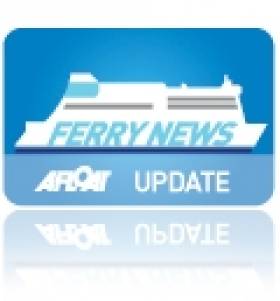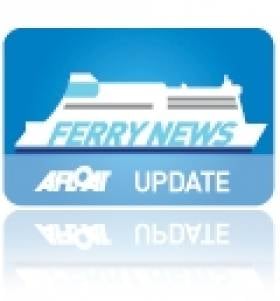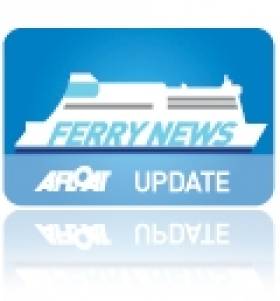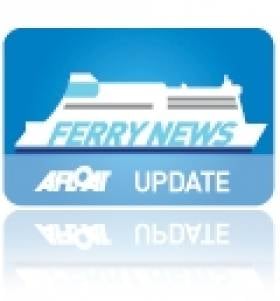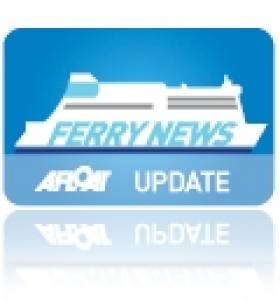Displaying items by tag: FGS
Another Fine Performance
#SEATRUCK NEWBUILD - With the announcement of Seatruck Ferries new Belfast-Heysham route to open in May, the company have in the meantime introduced a newbuild this week on the Dublin-Heysham route, writes Jehan Ashmore.
Seatruck Performance brings additional capacity to the route to Lancashire and becomes the third newbuild to enter the Irish Sea where her sisters are operating Dublin-Liverpool sailings.
She has a length of 142 m, breadth of 25 m and a capacity of 151 units, which is 35 more than the earlier 'P' Class ships which have shifted elsewhere on the Seatruck network.
The final fourth vessel Seatruck Precision as previously reported is currently under construction at the FGS Flensburg yard in Germany and is expected to make her debut on the Irish Sea in June.
- Seatruck Ferries
- Seatruck Performance
- Seatruck Precision
- Irish Sea freightferry market
- Irish Sea freight haulage market
- Irish Sea roadhaulage sector
- Ports and Shipping News
- DubliLiverpool
- DublinHeysham
- BelfastHeysham
- FGS
- FGS Flensburg
- HeyshamMax newbuilds
- Pclass Seatruck newbuilds
- Port of Heysham
- New Irish Sea freightferry
Sister Powers On to Liverpool Route
#FREIGHT FERRY NEWS- Seatruck Power (2011/19,722grt) made her debut on the Dublin-Liverpool route last week, bringing an additional boost to freight capacity and follows her sister which only entered service in December, writes Jehan Ashmore.
The newbuild joins the leadship Seatruck Progress (see related report) on the central corridor service and another pair are due for completion by mid-year and are to be deployed on Seatruck's other Irish Sea routes.
The quartet, were all ordered from the Flensburger Schiffbau-Gesellschaft (FSG) yard in Germany. At 142m long, each of the 150-unit capacity newbuilds carry an additional 35 units compared to the 'P' class vessels, in which two of these vessels have been replaced from the Liverpool route.
Each sister has space for 2,166 lane freight metres spread across four decks, where on this particular deck hazardous and refrigerated cargo can be handled. They are also designed to carry rolling project cargo and heavy-lift items.
Seatruck Newbuild Making Progress On Irish Sea
#FERRY NEWS -Seatruck Ferries newbuild freight-only ferry, Seatruck Progress carried out berthing trials in Dublin Port yesterday in preparation to her debut on the Liverpool route over the festive period, writes Jehan Ashmore.
This was the inaugural call to the capital, though she had sailed across Dublin Bay earlier this month (as previously reported - click HERE) during her delivery voyage to Liverpool from German shipbuilders FGS Flensburger.
At 142 metres long and with a beam of 24 metres, the four decked ro-ro vessel, offers more capacity to the routes existing pair of 'Point' class vessels, as she can handle an extra 35 trailer units (each of 13.5m) than the Clipper Point and Clipper Pennant.
In February, the newcomer's second sister out of four on order, Seatruck Power is set to join her on the central corridor route.
Seatruck are the only Irish Sea operator dedicated to the carriage of un-accompanied freight traffic, though the vessels can cater for driver accompanied units with a limited number of cabins.
Seatruck’s New Freight-Ferry to Make December Debut
Seatruck, which claims 20% of the Irish Sea market compared to just 3.7% in 2004, says it will transport 300,000 units in 2011 on its four routes: Dublin-Liverpool, Dublin-Heysham, Warrenpoint-Heysham and Larne-Larne. With the introduction of the newer larger vessels, Seatruck is aiming at the 45% of Irish Sea freight market that is still driver-accompanied.
Alistair Eagles, MD of Seatruck (Irish Sea) says that his company's share of unaccompanied freight volumes is set to grow in 2012, although the total Irish Sea ro-ro market is set to remain static next year, but better than a 1% decline in 2011.
Mr Eagles said: "We believe that our sector of the market — freight-only unaccompanied — will continue to grow. By offering pure freight services we can keep the costs down relatively lower compared with the combined passenger and freight ferry operators.
"We are seeing a switch away from driver-accompanied shipments because hauliers can save quite a lot of money."
Seatruck also benefited from a radical shake-up on the Irish Sea ferry market, with largescale withdrawals of capacity by DFDS and other changes, notably taking over the Dublin-Heysham route in February, to read more click HERE. The route is served by the chartered 120-unit Anglia Seaways which has accommodation for 12 drivers.
As for the remaining newbuild pair, they are scheduled for delivery from FGS during the first half of 2012 and deployed on yet-to-be announced routes. Like the new quartet, the same number were ordered of the 'P' class which entered service from 2008 onwards which included Clipper Pace and Clipper Panorama which currently operate 22 weekly sailings on the Warrenpoint-Heysham route.
Seatruck also operate Clipper Ranger and Arrow on Larne-Heysham sailings, where they each provide a capacity of 65 units and offer driver accompanied traffic with accommodation in en-suite cabins.
Seatruck Ferries Second Ro-Ro Newbuild Launched
The remaining pair are due for delivery in June 2012 from the German shipbuilder Flensburger Schiffbau-Gesellschaft (FSG) located on the Baltic Sea, close to the Danish border.
Seatruck Ferries is a division of the Danish shipping giant Clipper Group, which operates four routes in the north Irish Sea. The company offer 80 sailings per week on four routes: Dublin-Heysham, Dublin-Liverpool, Warrenpoint-Heysham and Larne- Heysham.
First Heysham-Max Newbuild Launched for Seatruck Ferries
The quartet of Heysham-Max class vessels are the largest ever vessels built to operate from the Cumbrian port which has determined the length of the new ships. Despite the restrictions imposed by the dimensions of the port, the optimum cargo-load of the newbuilds were achieved by positioning the deckhouse forward so to guarantee un-hampered loading of the upper decks.
Propulsion is from two MAN 7L48/60CR main engines of 2 x 8,000kW providing 21 knots. The powerplant is designed to meet rigorous emission and fuel consumption demands, according to FSG managing director Peter Sierk.

